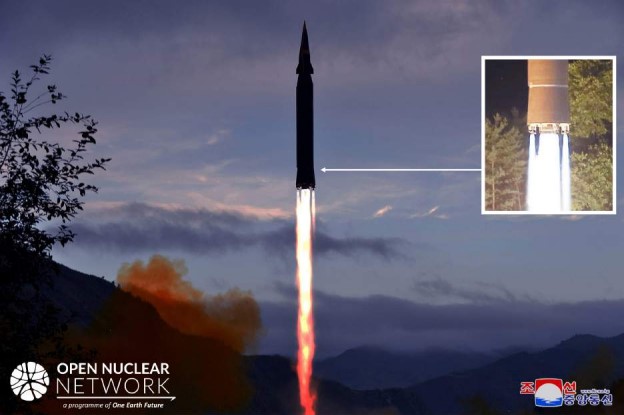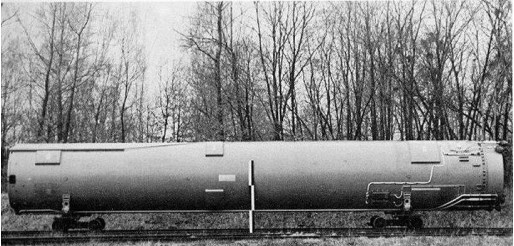
The Korean Central News Agency (KCNA) of the Democratic People's Republic of Korea (DPRK) reported that, in the morning of 28 September 2021, the Academy of Defence Science tested a hypersonic missile referred to as a Hwasong-8. Below are initial observations based on information released by KCNA.

Figure 1. The engine powering the Hwasong-8 appearsto have one main combustion chamber and four small combustion chambersto control flight attitude. Inset photo showsthe engine section of the Hwasong-14 ICBM. Images: KCNA
-
The engine of the Hwasong-8 seems to be the same type of engine used to power the Hwasong-12 intermediate-range ballistic missile (IRBM) and the first stage of the Hwasong-14 intercontinental ballistic missile (ICBM) (Figure 1).
-
From the images published by KCNA, it appears that a hypersonic glide vehicle was placed on top of the rocket stage as the payload of the Hwasong-8. As is typical of other hypersonic glide vehicles, the presence of fins on the vehicle indicate that aerodynamic 1 surfaces are used to control the flight attitude. This is not a sudden development as the DPRK has accumulated knowledge of hypersonic glide vehicles through the development of the KN-23 and KN-24 short range ballistic missiles. [1]
-
From the available information, it cannot be determined what flight trajectory was used for the Hwasong-8. In the past, the DPRK has tested its IRBMs in two ways. One way was to use a highly lofted trajectory, in which the missile flew almost vertically towards the sky and its warhead returned to earth in a nearly vertical angle. The other way was to use normal flatter trajectories to fly over Japan. In this case, there is no sign that the Hwasong-8 flew over Japan. However, a highly lofted trajectory could be problematic for testing a glide vehicle, because it would be difficult for the vehicle to glide in the air if it re-entered the atmosphere in a nearly vertical angle with great velocity. As of 29 September, the Republic of Korea, Japan and the United States have not released any official assessment about the trajectory of the Hwasong-8. [2] The possibility of a launch failure cannot be completely ruled out at this point.
-
However, KCNA reported that the flight process (including the flight of the rocket stage, the separation of the glide vehicle and the guided flight of the vehicle) was successful. If true, this test launch would make an important contribution to the development of a hypersonic glide vehicle. More significantly, it would also contribute to improving the overall reliability of the Hwasong-12 IRBM, and the Hwasong-14 and Hwasong-15 ICBMs for the following reasons: (1) it would mark the sixth consecutive flight success of the engine powering the Hwasong-12 and the Hwasong-14, and (2) the first stage engine of the Hwasong-15 is based on the same engine technology, although it has a higher thrust.
-
KCNA reported that the Hwasong-8 missile was the first DPRK missile to use a "fuel ampoule" and highlighted the "significance of turning all missile fuel systems into ampoules" in the future. "Ampoulization" (also referred to as encapsulation) was extensively used by the Soviet Union for its silo-based, liquid propellant ICBMs: after being filled with liquid propellant, the ICBM was put into a transport-launch canister (Figure 2), providing a favourable environment for the missile to remain ready for combat for years with minimal maintenance. It is possible that the Hwasong-8 may also be kept in, and launched from, a canister in order to improve its handling and reduce the preparation time required for a launch.

Figure 2. An ampoulized Soviet UR-100 ICBM in itstransport-launch canister. Image: Russia's Arms Catalog [3]
-
The Hwasong-8 test launch marks the first test of a ballistic missile of the IRBM class since 2017. It also demonstrates that the DPRK military industry is trying to fulfil the tasks set out during the Eighth Congress of the Korean Workers' Party in January 2021.
Attachment
KCNA text from 29 September 2021: Hypersonic Missile Newly Developed by Academy of Defence Science Test-fired
Pyongyang, September 29 (KCNA) -- The Academy of Defence Science of the DPRK test-fired a hypersonic missile Hwasong-8 newly developed by it in Toyang-ri, Ryongrim County of Jagang Province on Tuesday morning.
Pak Jong Chon, member of the Presidium of the Political Bureau and secretary of the Central Committee of the Workers' Party of Korea, watched the test-launch with leading officials in the sector of national defence science.
The development of the hypersonic missile, one of 5 top-priority tasks of the five-year plan facing the field of strategic weapon for the development of defence science and weapon system set forth at the 8th Congress of the Party, has been pushed forward according to a sequential, scientific and reliable development process.
The development of this weapon system which has been regarded as a top priority work under the special care of the Party's Central Committee is of great strategic significance in markedly boosting the independent power of ultra-modern defence science and technology of the country and in increasing the nation's capabilities for self-defence in every way.
In the first test-launch, national defence scientists confirmed the navigational control and stability of the missile in the active section and also its technical specifications including the guiding maneuverability and the gliding flight characteristics of the detached hypersonic gliding warhead.
It also ascertained the stability of the engine as well as of missile fuel ampoule that has been introduced for the first time.
The test results proved that all the technical specifications met the design requirements.
Pak Jong Chon mentioned the strategic importance of the development of the hypersonic missile and its deployment for action. He also noted the military significance of turning all missile fuel systems into ampoules.
He stressed the need for all the defence science research teams and workers of the munitions industry to rise up with higher spirit to implement the decisions made at the 8th Party Congress true to our Party's policy of prioritizing defence science and technology and thus make greater successes in the work of increasing the country's defence capabilities thousand-fold.
[1] A hypersonic aerial vehicle is an aerial vehicle that travels at the speed of Mach 5 or above and can perform maneuvers during flight. Both KN-23 and KN-24 meet this criteria.
[2] The Yonhap News Agency quoted unnamed sources as saying the missile flew 200 km and reached an apogee of 60 km. However, this is not an official statement from the Joint Chiefs of Staff. See: Oh Seok-min, N. Korea fires one short-range missile into East Sea: JCS, Yonhap News Agency, 28 September 2021, available at: https://en.yna.co.kr/view/AEN20210928000455325
[3] Russia's Arms Catalog, Volume IV, Strategic Missile Forces, 1996-1997, Moscow: Military Parade